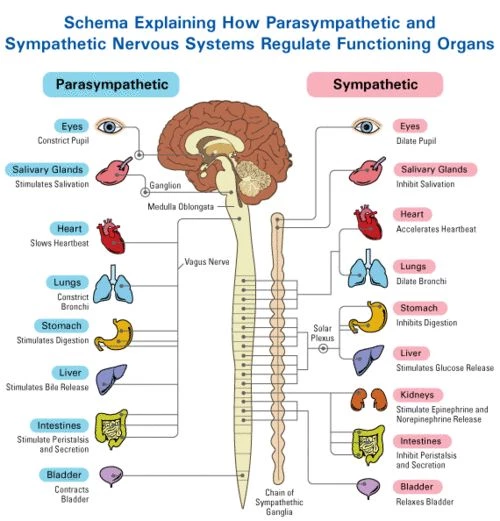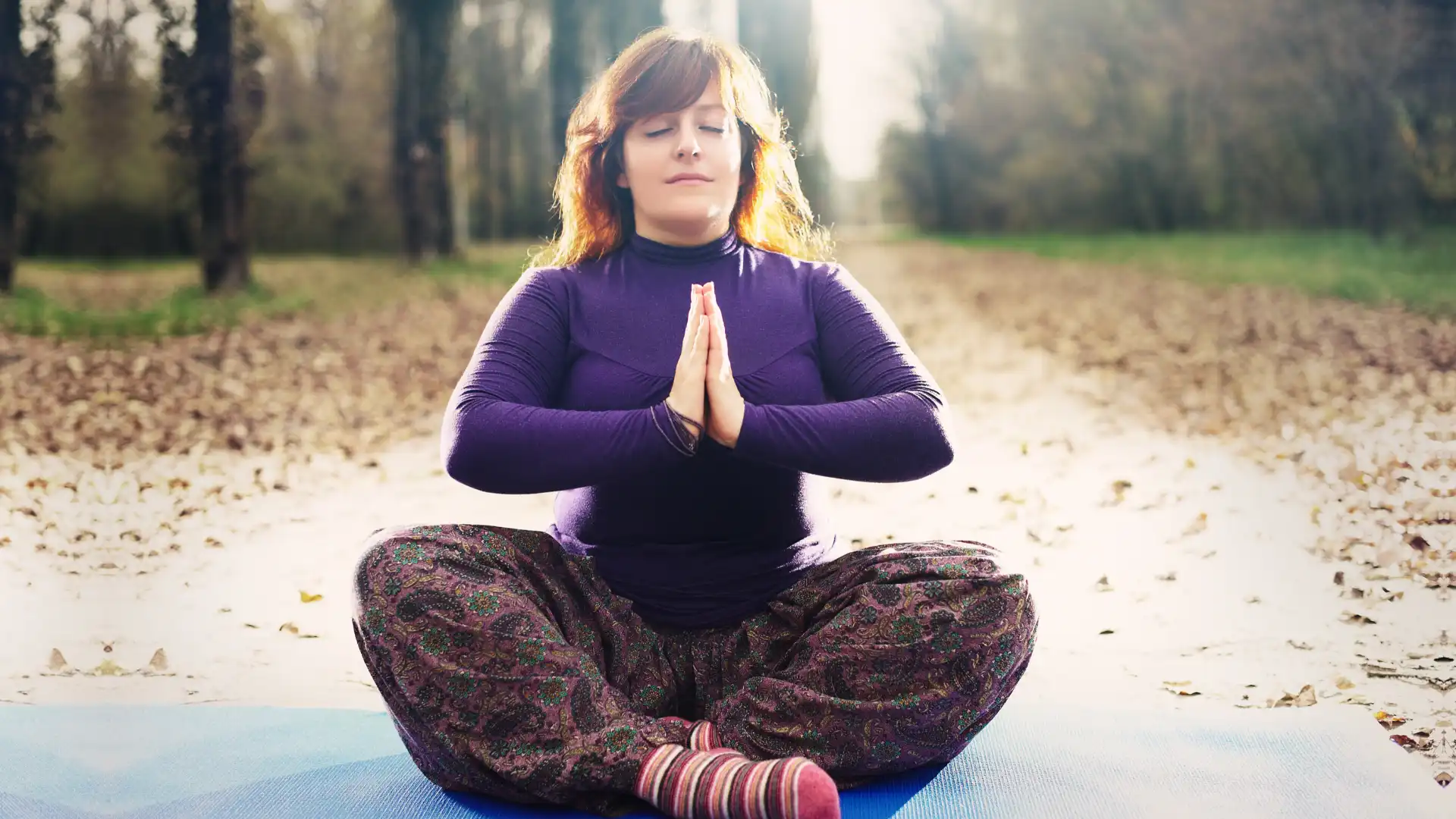Vagus Nerve Yoga: A Mind-Body Approach to Wellness

The vagus nerve plays a central role in your emotional and physical health. The vagus nerve extends from the brainstem down into your stomach and intestines, enervating your heart and lungs, and connecting your throat and facial muscles. Therefore, any yoga practices that stimulate these areas of the body can have a profound influence on the tone of the vagus nerve. Vagus nerve yoga helps you reclaim balance of body and mind using tools of mindfulness, conscious breathing, and physical postures.
“Healthy vagal tone can be thought of as an optimal balance of parasympathetic and sympathetic nervous system actions that allows you to respond with resilience to the ups and downs of life. Read on to learn 7 Vagus Nerve Yoga practices that will help you better manage stress and reclaim emotional balance.” – Dr. Arielle Schwartz
The Vagus Nerve and Your Health

Your nervous system is built around the balance of two opposing actions. The sympathetic nervous system is associated with the fight-or-flight response that is the result of the release of cortisol (stress chemicals) throughout the bloodstream. The parasympathetic is associated with relaxation, digestion, and regeneration. These two parts of your autonomic nervous system are meant to work in rhythmic alternation, a process that supports healthy rhythms of alertness and restfulness that facilitate physical and mental health.
Unfortunately, chronic stress and unresolved trauma interfere with the balance between the sympathetic and parasympathetic functions of your nervous system. Because we live in a world that is over stimulating and activating for the sympathetic nervous system, many of us need access to tools that help us engage the parasympathetic nervous system on a daily basis.
The vagus nerve has an inhibitory influence upon the sympathetic nervous system activity. In other words, practices that stimulate the vagus nerve have a calming effect on your body and mind. It is also important to recognize that individuals with unresolved PTSD (post-traumatic stress disorder) often resort to a primitive expression of the parasympathetic nervous system which can lead to symptoms of fatigue or depression. When left untreated, chronic stress and unresolved PTSD can disrupt your physical, mental, and emotional health. The good news is that practices that focus on stimulating the vagus nerve can help regain balance if you are either keyed-up with anxiety or shut down with fatigue.

An increase in vagal tone is linked to a reduction in inflammation and better prognosis in people suffering from chronic illness, anxiety, or depression. Vagal tone is measured in the changes in heart rate that occur with the breath. This is referred to as heart rate variability or HRV. Healthy vagal tone involves a slight increase in heart rate on the inhalation and a decrease of heart rate when you exhale. Vagal tone can be thought of as an optimal balance of parasympathetic and sympathetic nervous system actions. People with higher heart rate variability can move more easily from excitement to relaxation, and can recover more easily from stress.
You can learn how to regulate the functioning of your vagus nerve with techniques such as altering the rhythm of your breath, practicing mindful body awareness, and exploring physical yoga postures to create greater choice about your level of arousal or activation. For example, with somatic awareness, you can alter your breathing rhythm to facilitate a state of relaxed alertness. This can help you tap into an optimal level of focus and attention that is often described as “being in the zone” or the experience of “flow” that fuels your creativity. In addition, you can learn specific breathing practices that help you relax in the evening and prepare for restful sleep.
Vagus Nerve Yoga
The goal of a vagus nerve yoga practice is to become increasingly flexible, but not in the physical body but in the nervous system. Research has shown tremendous benefits of yoga for increased vagal tone, (1) stress reduction, and trauma recovery. This will help you become skilled at switching between the sympathetic and parasympathetic nervous system with greater ease and choice. The following seven vagus nerve yoga practices will help you develop healthy vagal tone, energize as needed, relax as desired, and reclaim balance in your life:
1. Conscious Breathing: The most immediate way to change the balance of sympathetic and parasympathetic nervous system actions is with the breath. To counterbalance any overstimulation of the sympathetic nervous system, vagus nerve yoga focuses on diaphragmatic breathing and extending the length of the exhalation. Research has found that slow, rhythmic, diaphragmatic breathing increases healthy vagal tone. (2) One form of yogic breathing is Ujjayi pranayama, which creates a slight constriction in the back of the throat by engaging your whisper muscles.
- To learn this breath, exhale out of your mouth as if you are fogging up a mirror.
- Now, breathe in the same manner but close your mouth and exhale out of your nose. You will notice the sound of your breath is louder, which often sounds like the waves of the ocean.
- Start with an even count for your inhalation and exhalation. For example, inhale to the count of 4 and exhale to the count of 4.
- For even deeper relaxation, gradually increase the length of your exhalation as compared to the inhalation. For example, you might start out with a 4 count on the inhalation and exhale to a 6 or 8 count. This has a calming effect on your parasympathetic nervous system.
2. Half-Smile: Engaging a “half-smile” is a valuable way to change your mental state and cultivate a serene feeling in the moment. Since the vagus nerve extends into the muscles of the face, you can increase vagal tone by relaxing the muscles of your face and then slightly turning up your lips. This practice helps to engage what Dr. Stephen Porges calls the “social nervous system,” the most evolved branch of the vagus nerve. As you smile, imagine your jaw softening and a relaxed feeling spreading across your face, your entire head, and down your shoulders. Notice the subtle changes in the quality of your thoughts and emotions.
3. Open Your Heart: You can gently stimulate the vagus nerve with yoga postures that open across your chest and throat. Try this gentle seated heart-opening practice:
- Bring your hands to your shoulders.
- Inhale as you expand across the front of your chest, open your elbows wide, and lift your chin.
- Exhale as you contract your elbows in front of your heart and tuck your chin.
- Take several deep breaths in this moving meditation. Focusing on your inhalation in this breathing pattern can be stimulating and uplifting. Allow yourself to expand into the open heart.
4. Wake Up and Stretch: If you are having a hard time waking up in the morning or if you are feeling tired and sluggish in the afternoon, yoga can provide a gentle pick-me-up for your mind and body. Explore standing postures such as Virabhadrasana I, II or III (Warrior Poses I, II or III) to invigorate your mind and wake up your body. Notice the connection of your feet to the earth to stay grounded to energize yourself in a balanced manner. Allow the breath to remain rhythmic so that you stay rooted and connected to the sensations in your body.
5. Release the Belly: You can work with the connection of the vagus nerve as it passes through your belly.
- Find your way into Bharmanasana (Tabletop Pose) with your hands underneath your shoulders and your knees underneath your hips. If there is any discomfort in your knees you can place a folded blanket underneath you.
- As you inhale, begin to lift your head and your hips lowering your belly toward the floor as you move into Bitilasana (Cow Pose).
- On your exhalation, lower your head and hips while you lift your spine into Marjaryasana (Cat Pose). Find your own timing of the movement with your breath.
- Repeat as many times as you like creating a gentle massage for your belly and spine.

6. Self-Compassion or “Lovingkindness” Meditation: Self-compassion and the practice of “lovingkindness,” ask you to engage in the act of friendliness toward yourself and others. Research on individuals who practice a lovingkindness meditation (3) revealed increased vagal tone, greater autonomic flexibility, an increased sense of social connectedness, and more positive emotions.
- Take a moment to reflect on a challenge you are facing in your life.
- Now, imagine someone else facing a similar challenge. Can you evoke a sense of compassion or kindness toward this other person?
- Notice how this feeling of compassion feels in your body. Wish them well.
- See if you can extend that same quality of loving-kindness toward yourself? Wish yourself well.
7. Yoga Nidra: Restorative yoga can help you slow down and calm the nervous system. One classic practice is Yoga Nidra, which is often referred to as “yogic sleep” or a meditation in relaxation. Yoga Nidra is the antidote to our stressful, modern lifestyle and offers an opportunity to restore body and mind through accessing the parasympathetic nervous system.
- Find a relaxing position lying on the floor, blanket, or yoga mat.
- Cultivate awareness of your body and breath. Make space for whatever you are feeling, including any areas of tension, heaviness, or constriction.
- Allow yourself to remain still for 30 minutes for a deeply relaxing and nourishing experience.
Also, read...
Free Yoga Video: Breathing for Pelvic Floor Health: Two Practices to Deepen Your Breath
How Healthy Is Your Nervous System: Polyvagal Theory Made Simple
Related courses
Breath as Medicine: Yogic Breathing for Vital Aging
Yoga and Myofascial Release: Releasing Chronic Tension with the Bodymind Ballwork Method

Dr. Arielle Schwartz is a licensed clinical psychologist, wife, and mother in Boulder, CO. She offers trainings for therapists, maintains a private practice, and has passions for the outdoors, yoga, and writing. She is also the developer of Resilience-Informed Therapy which applies research on trauma recovery to form a strength-based, trauma treatment model that includes Eye Movement Desensitization and Reprocessing (EMDR), somatic (body-centered) psychology, mindfulness-based therapies, and time-tested relational psychotherapy.
- Tyagi, A., & Cohen, M. (2016). Yoga and heart rate variability: A comprehensive review of the literature. International journal of yoga, 9(2), 97–113. https://doi.org/10.4103/0973-6131.183712
- https://www.frontiersin.org/articles/10.3389/fpsyg.2014.00756/full
- https://www.psychologicalscience.org/news/releases/social-connections-drive-the-upward-spiral-of-positive-emotions-and-health.html



